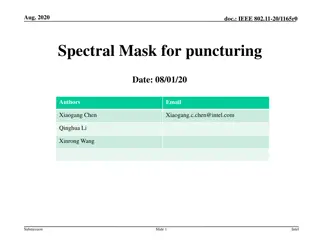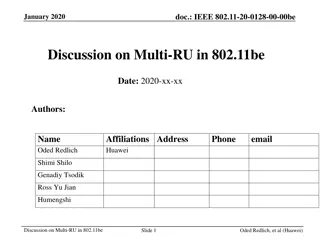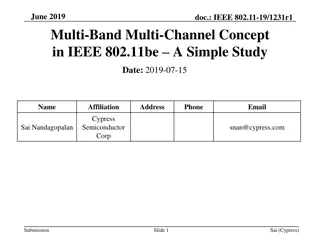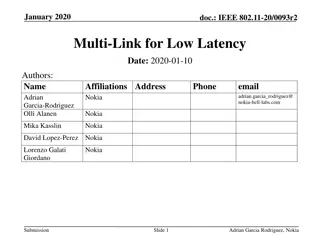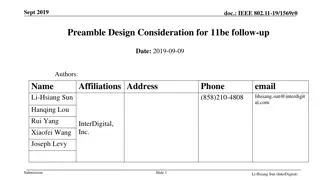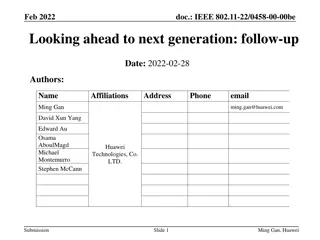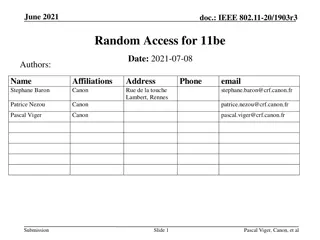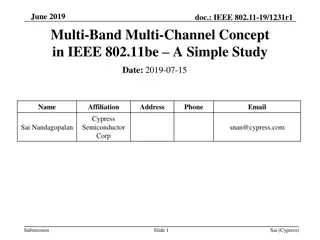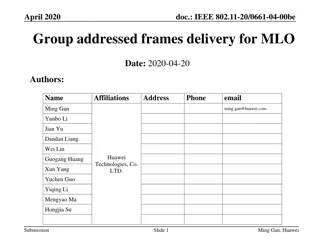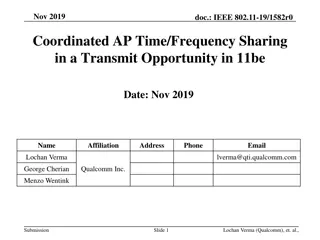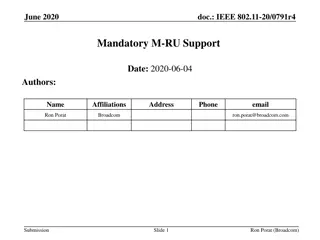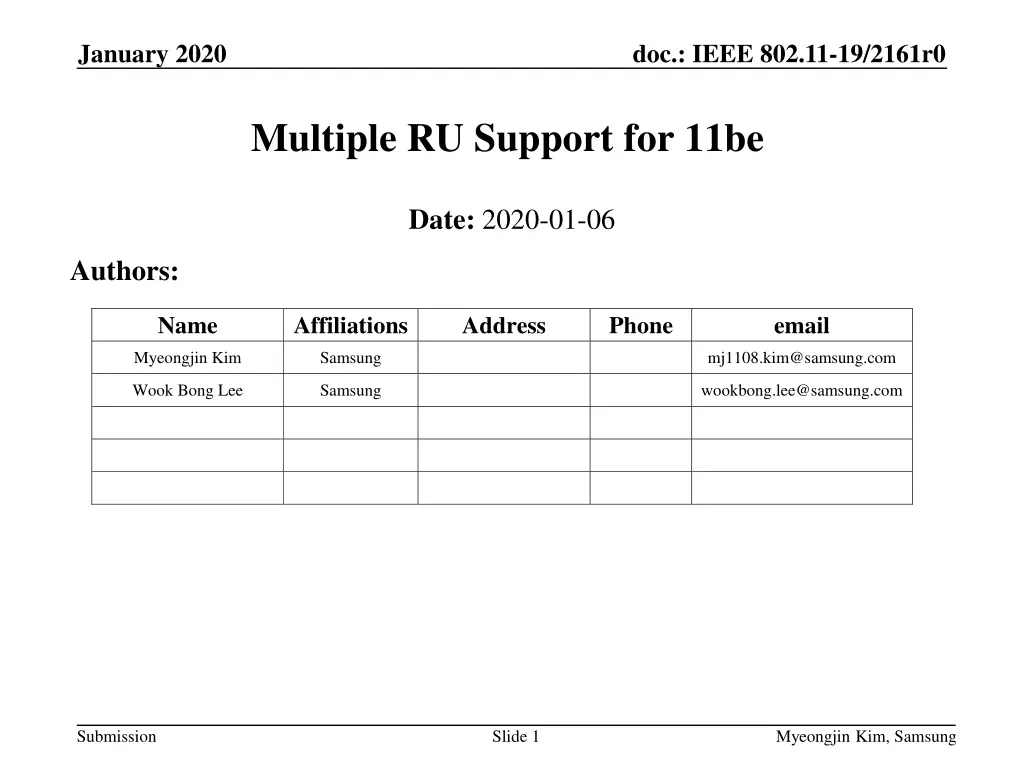
Enhancing Spectral Efficiency through Multiple RU Allocation in IEEE 802.11be
Exploring options for allocating multiple RUs in IEEE 802.11be to boost spectral efficiency with minimal complexity. Options include defining new RU types, RU aggregation, assigning multiple RUs to a single STA, and puncturing for efficiency enhancement. Considerations for reducing complexity while increasing efficiency are discussed in detail.
Download Presentation

Please find below an Image/Link to download the presentation.
The content on the website is provided AS IS for your information and personal use only. It may not be sold, licensed, or shared on other websites without obtaining consent from the author. If you encounter any issues during the download, it is possible that the publisher has removed the file from their server.
You are allowed to download the files provided on this website for personal or commercial use, subject to the condition that they are used lawfully. All files are the property of their respective owners.
The content on the website is provided AS IS for your information and personal use only. It may not be sold, licensed, or shared on other websites without obtaining consent from the author.
E N D
Presentation Transcript
January 2020 doc.: IEEE 802.11-19/2161r0 Multiple RU Support for 11be Date: 2020-01-06 Authors: Name Affiliations Address Phone email Myeongjin Kim Samsung mj1108.kim@samsung.com Wook Bong Lee Samsung wookbong.lee@samsung.com Submission Slide 1 Myeongjin Kim, Samsung
January 2020 doc.: IEEE 802.11-19/2161r0 Introduction In the September 2019 meeting, 11be task group has approved that 11be shall allow more than one RUs to be assigned to a single STA [1]. In [2] and [3], dividing RU sizes into small {26,52,106} and large {242,484,996} was discussed. In this contribution, we address the four possibilities of multiple RU allocation. Submission Slide 2 Myeongjin Kim, Samsung
January 2020 doc.: IEEE 802.11-19/2161r0 Options of Multiple RU Allocation Considering that the multiple RUs should be supported to enhance the spectral efficiency with increasing complexity as little as possible, we can sequentially think the following options of multiple RU allocation for 11be. Option 1: new RU type Defines the new RU sizes (e.g. RU26+RU52 becomes 78-tone RU) Coding across multiple RUs Option 2: RU aggregation Aggregation of contiguous or non-contiguous RUs Coding across multiple RUs using new module like RU parser Option 3: multiple independent RUs to a single STA Combinations of contiguous or non-contiguous RUs Independent coding for each RU Option 4: puncturing Submission Slide 3 Myeongjin Kim, Samsung
January 2020 doc.: IEEE 802.11-19/2161r0 Option 1: New RU Type We consider only contiguous RU allocation in this option. The new RU type is defined by combining multiple RUs. For example, RU26+RU52 becomes 78-tone RU. Need to define BCC inter-leaver as well as LDPC tone mapper for new RU size In order to reduce the complexity increase in defining the new RU type, the following things should be considered. The number of RUs that can be combined should be limited. In order to reduce the number of possible RU combinations For example, RU combinations of RU26+RU26+RU26 is not useful because AP can allocate RU52+RU26 to that STA. The number of RU combinations should be limited. In order to reduce the scheduling and signaling complexity For example, the combinations of contiguous RUs within each 20MHz can be introduced. For example, RU26+RU484 can not be applicable because it does not increase the spectrum efficiency much. Therefore, balancing between complexity and the number of supported RU combinations is important. This option can reuse the existing signaling method in 11ax by expanding RU Allocation subfield. Submission Slide 4 Myeongjin Kim, Samsung
January 2020 doc.: IEEE 802.11-19/2161r0 Option 2: RU Aggregation RU 1 Encoder Parser PSDU RU N Contiguous or non-contiguous RUs are aggregated. Option 2 can reuse the existing transmitter procedure excepting that this needs new module like RU parser after encoding. In terms of de-interleaving and decoding latency, Option 1 and Option 2 are not so different because PHY will typically do the following two stage mapping: 1) From RU allocation, find out which RU or RUs are allocated the receiving STA 2) From RU indices, find out subcarriers indices However, in terms of signaling, Option 2 increases the latency because we either need multiple mapping engine (then we need to know what's the maximal aggregation order) or do it sequentially for aggregated RUs. Submission Slide 5 Myeongjin Kim, Samsung
January 2020 doc.: IEEE 802.11-19/2161r0 Option 3: Multiple Independent RUs to a Single STA Encoder 1 Encoder 1 RU 1 RU 1 PSDU 1 or Parser PSDU Encoder N Encoder N RU N RU N PSDU N The bits are distributed into multiple RUs before encoding or there are multiple PSDU corresponds to each RU. Then, the bits in each RU are encoded independently. Similar to Option 2, Option 3 also needs new module like RU parser before encoding or changes in MAC (multiple PSDUs). It provides higher flexibility (regarding MCS) than Option 2. But, there is no frequency diversity gain among multiple RUs due to separated encoding. Submission Slide 6 Myeongjin Kim, Samsung
January 2020 doc.: IEEE 802.11-19/2161r0 Pros and Cons of Options 1, 2 and 3 Pros Cons Low complexity increase Similar signaling method in 11ax Limited flexibility of combinations Need to define new inter-leaver and LDPC tone mapper Option 1: new RU type Higher complexity than Option 1 Higher signaling overhead than Option 1 which may increase latency Needs new module like RU parser Significantly increases the number of RU combinations Option 2: RU aggregation Flexibility of aggregations Fully utilizes the diversity gain Highest complexity increase Needs new module like RU parser or changes in MAC (multiple PSDUs) Higher signaling overhead than Option 1 Full diversity gain is not achieved. Option 3: Full flexibility regarding aggregations and MCS multiple independent RUs to a single STA Submission Slide 7 Myeongjin Kim, Samsung
January 2020 doc.: IEEE 802.11-19/2161r0 Option 4: Puncturing Option 4 is for combining RUs by allowing RU/RUs to be punctured. This option is suitable for large size RUs because introducing preamble puncturing of <20MHz in 11be will have coexistence issue with legacy devices [4]. In terms of signaling, this option can utilize the existing signaling method in 11ax to indicate the assigned multiple RUs of large size. For example, Bandwidth field to tell which 20MHz is punctured and use RU size by RU Allocation subfield which includes entire RU/BW, punctured and non-punctured RUs Bandwidth field == 4 (puncturing secondary 20MHz from 80MHz) + RU Allocation subfield == 208 means that 996 tone RU with secondary 20MHz is punctured (RU combination of RU242+RU484). Submission Slide 8 Myeongjin Kim, Samsung
January 2020 doc.: IEEE 802.11-19/2161r0 Summary Four options of 11be for support of assigning one or more RUs to a single STA in EHT MU PPDU are addressed. Option 1: new RU type Option 2: RU aggregation Option 3: multiple independent RUs to a single STA Option 4: puncturing Pros and cons of Option1, 2 and 3 have been discussed. For small size RUs, Option 1 is preferred because it provides not only the better performance with full diversity gain but also implementation convenience. For large size RUs, Option 4 is preferred due to the signaling and implementation convenience. Submission Slide 9 Myeongjin Kim, Samsung
January 2020 doc.: IEEE 802.11-19/2161r0 Straw Poll 1 Do you support that small-size RUs can be combined in the manner of Option 1 and large-size RUs can be allocated in the manner of Option 4? Submission Slide 10 Myeongjin Kim, Samsung
January 2020 doc.: IEEE 802.11-19/2161r0 Reference [1] 11-19/1262r6, Specification Framework for TGbe. [2] 11-19/1907r0, Multiple RU Combinations for EHT. [3] 11-19/1908r0, Multi-RU Support. [4] 11-19/1869r0, Preamble Puncturing and RU Aggregation. Submission Slide 11 Myeongjin Kim, Samsung


